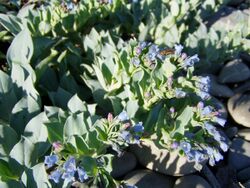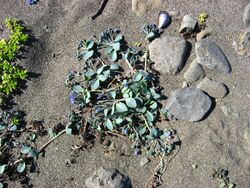Biology:Mertensia maritima
| Mertensia maritima | |
|---|---|

| |
| Scientific classification | |
| Kingdom: | Plantae |
| Clade: | Tracheophytes |
| Clade: | Angiosperms |
| Clade: | Eudicots |
| Clade: | Asterids |
| Order: | Boraginales |
| Family: | Boraginaceae |
| Genus: | Mertensia |
| Species: | M. maritima
|
| Binomial name | |
| Mertensia maritima (L.) Gray
| |
Mertensia maritima is a species of flowering plant in the borage family, and is known by the common names oyster leaf in North America, oyster plant in the British Isles, and sea bluebells.
It is restricted to gravelly sea shores, usually within reach of the highest winter tides in the Northern Hemisphere, reaching north to the northern parts of Canada , Greenland and Svalbard.
It is a perennial herb producing a stem approaching 50 centimeters in maximum length. The inflorescence forms a cluster of flowers which are first reddish, and later bright blue.
Description
Mertensia maritima is known as the oyster leaf or oyster plant because it gives off a faint smell of mushrooms and when eaten it tastes vaguely of oysters.[1] The chemical that gives this plant the oyster-like odour when its leaves are crushed is dimethyl sulphide, a compound that is noted for being a major part of the odour profile of raw oysters. .[2] It is native to Britain and Northern Europe; however, populations in the British Isles are decreasing. There are two other varieties that exist:
- M. maritima var. tenella is found in Canada and Spitzbergen
- M. maritima var. asiatica is found in Alaska and Northeastern Asia[1]
This plant grows on sand or shingle beaches where the ground can be siliceous or calcareous, and contains humus from decaying seaweed.[3] It mainly grows in a sub-Arctic climate and is exposed to very cold temperatures, waves that crash on the shore and strong winds.[4] Since the plant grows in a cold climate, the seeds remain dormant.[clarification needed] Skarpaas and Stabbetorp[citation needed] noted that a cold period (about 2 °C (36 °F)) was needed to break this dormancy.[5]
References
- ↑ 1.0 1.1 "Volatile composition of oyster leaf (Mertensia maritima (L.) Gray)". Journal of Agricultural and Food Chemistry 60 (47): 11681–90. November 2012. doi:10.1021/jf303395q. PMID 23140514. https://doi.org/10.1021/jf303395q.
- ↑ "Dimethyl Sulphide: The Oyster-like Odourant of Mertensia maritima)". Biosystematics and Ecology 2: 7–8_ _. November 2023. doi:10.1553/biosystecol.2.e113169. PMID 23140514.
- ↑ "Mertensia Maritima (L.) S. F. Gray". Journal of Ecology 51 (3): 733–742. 1963. doi:10.2307/2257760. ISSN 0022-0477. https://www.jstor.org/stable/2257760.
- ↑ "644. Mertensia Maritima" (in en). Curtis's Botanical Magazine 26 (1–2): 96–110. April 2009. doi:10.1111/j.1467-8748.2009.01640.x.
- ↑ "Micropropagation and Quantification of Bioactive Compounds in Mertensia maritima (L.) Gray". International Journal of Molecular Sciences 20 (9): 2141. April 2019. doi:10.3390/ijms20092141. PMID 31052234.
External links
- "Mertensia maritima". http://www.pfaf.org/user/Plant.aspx?LatinName=Mertensia+maritima.
- Global distribution
Wikidata ☰ Q1444376 entry
 |


